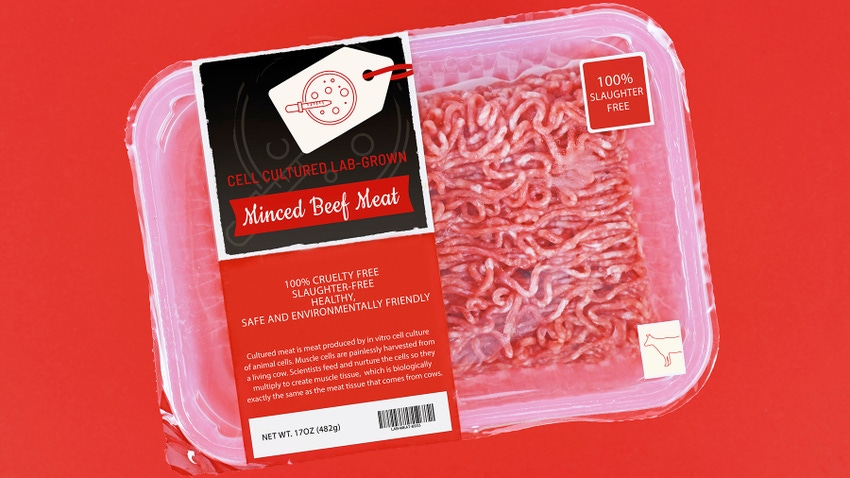Farm-to-table via petri dish
What the heck should we call lab-grown meat?

So what do you call a lab-grown protein containing animal byproducts but no slaughtered animals? It’s definitely not vegan, but it’s not really “meat” either. Or is it?
Currently, the preferred industry nomenclature is “cell cultivated meat.” Marketing studies have shown consumers are fairly comfortable with this term. But is it misleading or does it give lab meat a bad rap? That answer depends on who you ask.
What exactly is cell cultivated meat?
Cell-cultivated meat is made in a lab using animal cell samples. Dutch scientist Mark Post from Maastricht University in The Netherlands developed the first lab-grown meat product for human consumption in 2013.
Today, more than 150 companies across the world sell cell cultivated meat, including 43 in the United States.
But don’t expect to grab an Amsterdam lab burger just yet. The product is currently banned in The Netherlands as well as in the rest of Europe. Only the U.S., Singapore and a few other nations allow cell cultivated meat sales to consumers.
Despite this, more than $3 billion in private capital was invested in cell cultivated meat between 2016 and 2022.
In July 2023, Upside Foods sold the first lab-grown chicken to restaurants in San Francisco and Washington, D.C. That same month, government officials in The Netherlands authorized limited cell cultivated meat tastings held in controlled environments.
No word yet on what wine it pairs best with.
What’s in a name? A lot more than you might think.
USDA currently allows faux meat to be marketed as either “cell cultured meat” or “cell cultivated meat.” Deputy Undersecretary for Food Safety Sandra Eskin says new federal labeling rules should be coming soon. The agency has received thousands of comments on the issue. Multiple states are also drafting rules for how lab-grown meats can be marked and sold in their jurisdictions.
Eskin recently hosted a panel discussion on lab meat labeling during the USDA Agricultural Outlook forum in Washington. She says there have been all kinds of suggestions for what to call these meat-adjacent products. Some companies would like to simply use “cultivated” meat. Others prefer “fake meat,” “imitation meat,” “clean meat,” “manufactured meat” and “cell-based meat.”
Someone even suggested “in vitro meat.” (Can you say yum?)
Competing agendas
A Congressional bill introduced earlier this year called the Fair Foods Act would mandate stricter labeling rules for cultivated meat. It’s one of several efforts on the state and federal level supported by major agricultural interests to enact stricter standards.
Madeline Cohen is a senior regulator attorney with The Good Food Institute, a nonprofit that promotes alternatives to animal products. She says the cultivated meat industry should be permitted to use familiar terms consumers prefer so long as they are accurate and not misleading.
According to her, labels should also communicate to consumers the benefits of cell-cultivated meat and how they can use them. As regulatory agencies consider labeling guidelines, she believes it’s important to ensure a level playing field and ensure the government isn’t picking winners and losers in the marketplace.
“Sometimes regulations can inadvertently disparage new products or put them at a disadvantage simply because they’re new and they therefore have more restrictive or specific labeling requirements than products that have been on the market for a long time,” she says.
Cohen says TGFI favors using “cultivated meat” because the process for cultivating lab meat is similar to cultivating products like tomatoes. As for differentiating from traditional meat, she says the term does exactly that since beef, poultry and pork products are not market as “cultivated.”
Brian Roholm, the director of food policy for Consumer Reports, believes labels should be simple. While omitting the word “cell” may be a step too far, he has no issues with the term “cell cultivated meat.” However, he worries labels may leave out key information from the production process that’s important to consumers.
For example, when cultivated cell chicken is created, chicken cell lines are placed in a liquid that contains fetal bovine serum. Then, an anti-clumping agent FDA previously approved as a stool softener is added. Some products may also contain material from cattle and pigs.
“Given that the cell cultured chicken products contain material that was derived from cows and pigs, it would seem that the information should be inclined on the label because it is a material fact,” Ronholm says. “And consumers certainly would not expect products to contain these materials so this information would of importance to them.”
He emphasized that this information would be especially important to people who avoid consuming those animals for religious reasons or personal beliefs. He also notes using animal parts calls into question the “cruelty-free” labels some companies use on their packaging.
Do labels even matter?
Despite the massive investments in cell cultivated meat, the industry is likely decades away from competing with traditional agriculture, if it ever does. The process of creating lab-grown meat is still a work in progress. Even with improvements, nobody has figured out how best to distribute cultivated meat on a meaningful scale.
Roholm points to a recent New York Times article detailing widespread pessimism about cultured meat’s future. While he wants the technology to work because of its potential benefits to sustainability and climate change, he wonders if all the money and effort could have been better spent addressing other food issues.
“We could have been using that money to figure out how we can produce salmonella-free chicken or how we can make fresh produce safer,” he says. “It’s frustrating from a consumer standpoint that you see all of this for something that has had very very little impact at this point.”
About the Author(s)
You May Also Like





